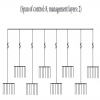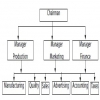Home | ARTS | Management Concepts & Organisational Behaviour
|
Classical Thinking on Span of Control - Organisation Structure And Design
Management Concepts & Organisational Behaviour - Organisation Structure And Design
Classical Thinking on Span of Control - Organisation Structure And Design
Posted On :
As explained above, the traditional theory of management was much concerned with the specific number of subordinates that could be supervised by a manager.
Classical Thinking on Span
of Control
As explained above, the traditional theory of management was much concerned with the specific number of subordinates that could be supervised by a manager. For instance, Lyndall Urwick suggests that no executive should attempt to supervise directly more than five. Different thinkers suggested different spans both at the top and lower levels of organization.
The contribution of V.A. Graicunas was however, significant to the span of management theory. According to him, in selecting a span managers should consider not only the direct one-to-one relationship with their subordinates, but also two other kinds of relationships, namely, direct group relationships and cross-relationships. As such, if A has two subordinate B and C, the following relationships would emerge.
Direct one-to-one relationships: These relationships relate the superior directly with his subordinates, A in this case will have two direct relationships with B and C, viz., A to B and A to C.
Direct Group relationships: This refers to the relationships of superior with the various possible
combinations of subordinates. In the above example, A may interact with B in
the presence of C or with C in the presence of B. Graicunas argues that though
the individuals are same, the two situations have different implications.
Cross – relationships: This type of relationships is created when subordinates consult one
another. In our example, the two cross relationships are B with C and C with B.
Graicunas gave a formula to ascertain the number of all the three kinds of
relationships:

n stands for the number of subordinates. One can easily ascertain how the number of relationships increases as the number of subordinates rises by applying this formula.
With four subordinates, the total relationships go up to 44, with five subordinates to 100, with six subordinates to 222, and with 10 subordinates to 5,210. Though Graicunas formula explains the complexities involved as the number of subordinates increase, it suffers from the following inadequacies.
-- The formula ignores the frequency and importance of relationships, and
-- Several other factors which have a bearing on the superior subordinate relationships have not been taken into consideration.
As explained above, the traditional theory of management was much concerned with the specific number of subordinates that could be supervised by a manager. For instance, Lyndall Urwick suggests that no executive should attempt to supervise directly more than five. Different thinkers suggested different spans both at the top and lower levels of organization.
The contribution of V.A. Graicunas was however, significant to the span of management theory. According to him, in selecting a span managers should consider not only the direct one-to-one relationship with their subordinates, but also two other kinds of relationships, namely, direct group relationships and cross-relationships. As such, if A has two subordinate B and C, the following relationships would emerge.
Direct one-to-one relationships: These relationships relate the superior directly with his subordinates, A in this case will have two direct relationships with B and C, viz., A to B and A to C.

n stands for the number of subordinates. One can easily ascertain how the number of relationships increases as the number of subordinates rises by applying this formula.
With four subordinates, the total relationships go up to 44, with five subordinates to 100, with six subordinates to 222, and with 10 subordinates to 5,210. Though Graicunas formula explains the complexities involved as the number of subordinates increase, it suffers from the following inadequacies.
-- The formula ignores the frequency and importance of relationships, and
-- Several other factors which have a bearing on the superior subordinate relationships have not been taken into consideration.
Tags : Management Concepts & Organisational Behaviour - Organisation Structure And Design
Last 30 days 925 views















